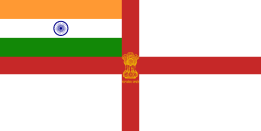Nilgiri-class frigate
| Class overview | |
|---|---|
| Name: | Nilgiri class |
| Builders: | Mazagon Dock Limited |
| Operators: |
|
| Succeeded by: | Godavari class |
| Completed: | 6 |
| Retired: | 6 (INS Vindhyagiri was sunk but salvaged and later retired) |
| General characteristics | |
| Type: | Frigate |
| Displacement: |
|
| Length: | 113 m (371 ft) |
| Beam: | 13 m (43 ft) |
| Draught: | 4.3 m (14 ft) |
| Propulsion: |
|
| Speed: | 28 kn (52 km/h; 32 mph) |
| Range: | 4,000 nmi (7,400 km; 4,600 mi) at 12 kn (22 km/h; 14 mph) |
| Complement: | 267 (incl 17 officers)[1] |
| Sensors and processing systems: |
|
| Armament: |
|
| Aircraft carried: | 1 Westland Sea King or HAL Chetak |
The Nilgiri-class frigates are updated versions of the Leander class, designed and built for the Indian Navy by Mazagon Dock Limited in Mumbai. Six ships were built between 1972-81. Vessels of the class formed the 14th Frigate Squadron. The lead ship INS Nilgiri was the first major warship to be built in India in collaboration with Yarrow Shipbuilders of the United Kingdom.
The class and its lead ship, INS Nilgiri are named for the Nilgiri Hills. Subsequent ships in the class are also named for hill ranges of India.
When the British refused to provide license production of the radar suite, the Indian Navy teamed up with Signaal of Netherlands to license-build a similar radar search, tracking and fire control suite in India, which went into the latter five ships. Improved versions of the Signaal search radar continues to be fitted in later classes of Indian Navy ships. The last two ships, INS Vindhyagiri and INS Taragiri were modified significantly with the addition of a Sea King ASW helicopter, a collapsible Canadian hangar, ILAS 324 mm triple torpedo tubes and a Bofors ASW twin barrel mortar. This re-design was done indigenously by the Indian Navy and gave it much needed experience and confidence in ship-design and modification. They were also fitted with an indigenous ASW fire control action information system which was a first for the Indian electronics industry. This project was led by the late Captain (later Rear Admiral) Prakash N Gour. The British categorically refused to extend their design warranty to the Indian modifications which nevertheless proved to be a success.
The Nilgiri class has been decommissioned by the navy, with the entry into service of the Shivalik-class. Five ships have been decommissioned and one sunk in an accident. INS Taragiri was the last ship of the class to be decommissioned, on 27 June 2013 in Mumbai, after serving 33 years in the navy.[2][3]
History
The Nilgiri-class frigates served as the mainstay and workhorse of the Indian Navy during the 1980s and early 1990s and they formed the 14th Frigate Squadron. The last two vessels (Taragiri and Vindhyagiri) had more powerful engines than the earlier vessels.
Taragiri had a serious fire in July 1994, but was repaired and was back in active service in 1995. Westinghouse supplied the Indian Navy with ASW sonar systems, two hull mounted arrays and three variable depth sonar arrays which are installed inside towed bodies built by Fathom Ocean Ltd. Transducer elements in both cases are identical. INS Udaygiri underwent a refit at Naval Dockyard, Mumbai. The remaining vessels in the series were expected to have their armaments brought into line with later ships.
INS Himgiri was used as a trial ship for the indigenous APSOH (Advanced Panoramic Sonar Hull) sonar.
Ships
| Name | Pennant | Commissioned | Decommissioned | Comments |
|---|---|---|---|---|
| Nilgiri | F33 | 23 June 1972 | 31 May 1996 | Sunk on 24 April 1997, by a Sea Eagle AShM fired from a Sea Harrier Frs Mk.51 of the Indian Navy. |
| Himgiri | F34 | 23 November 1974 | 6 May 2005 | The vessel holds the distinction of having the maximum number of days at sea in single commission and was the first to shoot down a pilotless aircraft in 1976. Captain K N Zadu, VrC, (Retd.) who served as her first commanding officer, was the chief guest at the decommissioning ceremony along with Commander Ravneet Singh who served as her last commanding officer. |
| Udaygiri | F35 | 18 February 1976 | 24 August 2007[4] | |
| Dunagiri | F36 | 5 May 1977 | 20 October 2010 | Named after one of the Himalayan peaks. Her crest depicts the Osprey, a Himalayan bird and the ship's motto is 'Victory Is My Profession'. |
| Taragiri | F41 | 16 May 1980 | 27 June 2013 | The last ship to be decommissioned.[2][3] |
| Vindhyagiri | F42 | 8 July 1981 | 14 Jun 2012 [5] (15 Feb 2011 recovered) |
The ship suffered a collision with MV Nord Lake at Mumbai harbour on 30 January 2011 and sank after a fire on board. No casualties were reported. It was re-floated by TITAN Salvage and was decommissioned later with full honours in 2012. |
References
- ↑ Indian Naval Ships-Frigates-Giri Class Archived February 15, 2008, at the Wayback Machine.
- 1 2 "Naval ship INS Taragiri bows out of service". IDRW. 27 June 2013. Retrieved 27 June 2013.
- 1 2 "INS Taragiri bows out of service". Business Standard. 27 June 2013. Retrieved 27 June 2013.
- ↑ "32 years glorious service". stampsofindia.com. Retrieved 26 September 2014.
- ↑ "Списан злополучный индийский фрегат F-42 Vindhyagiri". flotprom.ru. 14 June 2012. Retrieved 26 September 2014.
External links
| Wikimedia Commons has media related to Nilgiri class frigate. |
